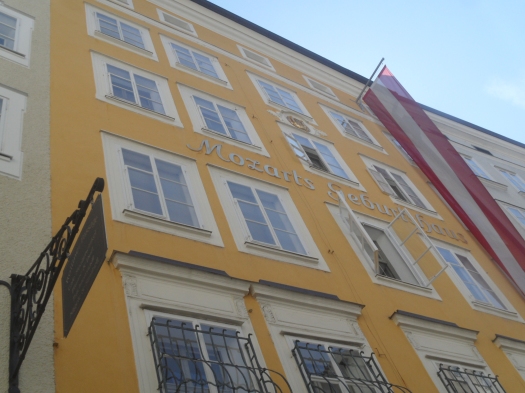During a recent trip to Salzberg, I got to do something I never thought I’d have the opportunity to do: stand in the presence of a legend. It wasn’t a living presence, but I felt him all the same. (No, I’m not going into some supernatural realm – that’ll scare me much more than it’d scare you, and I do need my sleep.)
Salzberg’s most famous son is, of course, Mozart. Wolfgang Amadeus Mozart. He’s one of those musicians every single person knows of, even haters of classical music. We’d have heard his name at least once in our lives, possibly with Eine kleine Nachtmusik, which is one of his most famous compositions.
Anyway, Mozart was born in Salzberg and his birth house is now a museum. A striking orange building nestled between other, less brightly coloured buildings. Impossible to miss. If you had seen me there, it’d be even more difficult to miss, seeing that I was practically incoherent in my joy at being there.

Mozart’s Birth House, Salzberg
There’s also another house, his living house, which I didn’t get to go into because I was travelling with a group who weren’t that into doing a Mozart walk. Mozart’s Residence, as this other place is called, is a pale pink building that was destroyed during WWII and subsequently reconstructed.
In terms of content, the birth house (Geburtshaus) contains objects like little mementos of Mozart’s, his childhood violin and the clavichord on which he composed pieces like The Magic Flute. The living house (Wohnhaus) contains compositions from his Salzberg years, and one that really intrigues me – a section devoted to the women in Mozart’s family, particularly his sister Nannerl, who was an extremely gifted pianist herself. Unfortunately, being a woman meant that she had to retire from public view and allow her brother to shine. I’d love to say we’re past that kind of attitudes, but sadly they remain very much in force even today.
In my daydreams, I’d have visited Mozart’s birth house all alone. I’d be standing in an empty room, feeling his aura around me as I looked at the things he once touched. The things he found familiar, that were so unfamiliar to me. The lock of hair, supposedly his. If only I could touch it. His violin, so different from my own. If I stood in that room and played, would I finally be able to play something decent? I had hoped his talent would infect me, somehow. But I came out as incompetent with the violin as ever.
The beauty of being in the house is really just being there. A museum is meant to present artifacts, it’s meant to show a life, not recreate it in its entirety. Of course, material objects are important. But by presenting them in glass cases, they become divorced from their context. I can see a purse that is worn out and know that Mozart must have valued it. But I cannot see him using it, I cannot see him holding it. I cannot see where he would place it in his home – in its own place of honour? Or perhaps where he’d have easy access to it? Did he unconsciously touch it for the comfort and familiarity it brings him?
In this museum, the explanations on the walls and the neat glass display cases remind me that I am not actually in Mozart’s time. But it was once his house. At some point, he must have stood at the place where I was standing, fingers scraping the walls just like my fingers were surreptitiously doing.
Salzberg doesn’t make it a secret that they adore Mozart. But the difference between what’s in the house and what’s outside it is the commercial aspect. As Salzberg’s most famous resident, Mozart souvenirs are everywhere. There is a statue of him at Mozartplatz. Chocolates are sold with his picture on them. Little piano souvenirs, little Mozart souvenirs…at some point, you feel it loses the personal touch.
The lived aspect – that’s what the place has in addition to the “museum” aspect. This museum is his actual house, and with some imagination, the experience is truly personal. Mozart wasn’t just a name behind those symphonies, concertos and operas, he was real.
If I could take another journey there, I’d visit the living house as well and find that house at Steingasse 25 where Mozart’s first violin was supposedly made. (As luck would have it, I went into Steingasse and forgot which house to look for.) I would like to spend more time at the grave of Nannerl, which is in the catacombs of the St. Peter’s Cemetery (Petersfriedhof). Incidentally, this cemetery is also where the Von Trapp family hid out in the musical, The Sound of Music. The catacombs is also the final resting place of Michael Haydn, the younger brother of Joseph Haydn, and a composer just like him. Not relating to a composer, but I can’t end this without mentioning Major General Harry J. Collins, who was part of the Rainbow Division of the U.S. Army which liberated the Dachau concentration camp. His grave is in the cemetery. You can read more about him at this link.
There are two graves final graves that I’d like to visit too. They are the graves of Mozart’s wife, Constanze and his father, Leopold. Both are located at the Saint Sebastian Cemetery (Sebastianskirche Friedhof). The two of them had a big influence on Mozart as a person and on his career (his father started his career). The journey wouldn’t feel complete without stopping by.
The journey, someday, when (and if) I return.








